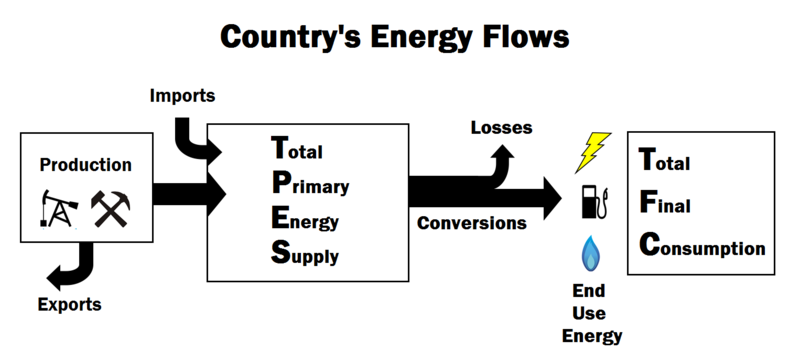Energy production: Difference between revisions
(Created page with "<onlyinclude>Energy production refers to how much primary energy a country extracts from nature. This is the total of all of the harvested fuels and flows. It is i...") |
energy>Jmdonev No edit summary |
||
| Line 1: | Line 1: | ||
<onlyinclude>Energy production refers to how much [[primary energy]] a country extracts from nature. This is the total of all of the harvested [[fuel]]s and [[flow]]s. | [[Category:Done 2020-02-29]] | ||
[[Category:Lecture 2B Energy around the world]] | |||
[[category:371 topics]] | |||
<onlyinclude>Energy production refers to how much [[primary energy]] a country extracts from nature. This is the total of all of the harvested [[primary fuel]]s and [[primary energy flow]]s. Note production ignores both imports and exports, and sums up what's extracted from nature.</onlyinclude> The primary energy available for use by a country after imports and exports is the [[total primary energy supply]], often referred to as [[TPES]]. Please see Figure 1 for a flowchart that explains how production becomes TPES and eventually the [[total final consumption]] (referred to as [[TFC]]). | |||
Energy production would include: | |||
*Any [[coal]], [[oil]] or [[natural gas]] that is extracted from the ground in that country (but not the [[fossil fuel]]s that are imported. | |||
*Any [[hydropower]], [[wind]], [[Geothermal energy|geothermal]], [[tidal power|tidal]] or [[solar power]] extracted from nature. | |||
*Electricity from [[nuclear power plant]]s, rather than the energy held in [[uranium]] that's been mined because there's so much more energy in the uranium than any of the other sources. The accounting for nuclear power is done differently, so only the [[electricity]] is considered. | |||
[[File:energyflows.png|800px|thumb|Figure 1. This diagram<ref>Created internally by a member of the Energy Education team.</ref> shows how production becomes [[TPES|Total Primary Energy Supply]] becomes [[TFC|Total Final Consumption]]. Various primary energy sources combine are changed with [[energy conversion technology|energy conversion technologies]] like [[power plant]]s and [[oil refinery|refineries]] to [[energy currency|energy currencies]].]] | [[File:energyflows.png|800px|thumb|Figure 1. This diagram<ref>Created internally by a member of the Energy Education team.</ref> shows how production becomes [[TPES|Total Primary Energy Supply]] becomes [[TFC|Total Final Consumption]]. Various primary energy sources combine are changed with [[energy conversion technology|energy conversion technologies]] like [[power plant]]s and [[oil refinery|refineries]] to [[energy currency|energy currencies]].]] | ||
| Line 6: | Line 14: | ||
In the data visualization below, click on different countries to see what the energy production looks like. The pie chart gives what fraction of the countries primary energy harvested from the environment is a particular source. Please note that for some countries production is bigger than [[TPES]] and for some countries production is smaller than [[TPES]] depending on how much energy is imported or exported. | In the data visualization below, click on different countries to see what the energy production looks like. The pie chart gives what fraction of the countries primary energy harvested from the environment is a particular source. Please note that for some countries production is bigger than [[TPES]] and for some countries production is smaller than [[TPES]] depending on how much energy is imported or exported. | ||
<html><iframe id='world-energy' class='charts-iframe topic-Production'></iframe></html> | <html><iframe id='world-energy' class='charts-iframe topic-Production'></iframe></html> | ||
[[ | |||
[[ | ==For Further Reading== | ||
[[ | *[[Primary energy]] and [[TPES]] | ||
*[[TFC]] | |||
*[[Fuel vs flow]] | |||
*[[Energy access]] | |||
*Or explore a [[Special:Random|random page]] | |||
==References== | |||
{{reflist}} | |||
[[Category:Uploaded]] | |||
Revision as of 20:53, 13 April 2020
Energy production refers to how much primary energy a country extracts from nature. This is the total of all of the harvested primary fuels and primary energy flows. Note production ignores both imports and exports, and sums up what's extracted from nature. The primary energy available for use by a country after imports and exports is the total primary energy supply, often referred to as TPES. Please see Figure 1 for a flowchart that explains how production becomes TPES and eventually the total final consumption (referred to as TFC).
Energy production would include:
- Any coal, oil or natural gas that is extracted from the ground in that country (but not the fossil fuels that are imported.
- Any hydropower, wind, geothermal, tidal or solar power extracted from nature.
- Electricity from nuclear power plants, rather than the energy held in uranium that's been mined because there's so much more energy in the uranium than any of the other sources. The accounting for nuclear power is done differently, so only the electricity is considered.

In the data visualization below, click on different countries to see what the energy production looks like. The pie chart gives what fraction of the countries primary energy harvested from the environment is a particular source. Please note that for some countries production is bigger than TPES and for some countries production is smaller than TPES depending on how much energy is imported or exported.
For Further Reading
- Primary energy and TPES
- TFC
- Fuel vs flow
- Energy access
- Or explore a random page
References
- ↑ Created internally by a member of the Energy Education team.

